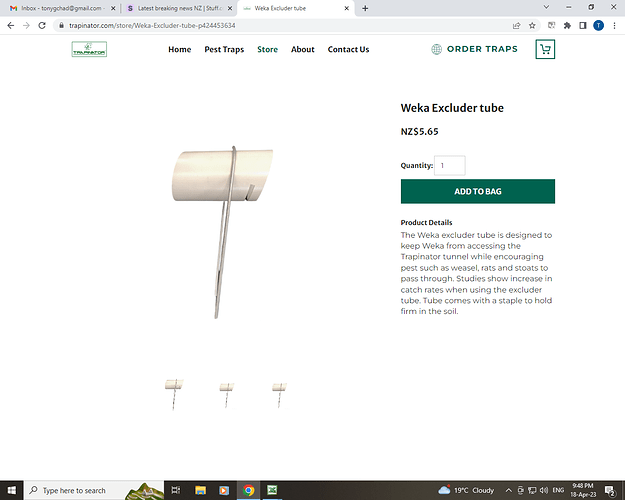Our trapping group in the Cobb Valley, Kahurangi NP, have been using mutton fat as bait and prefeed in our mustelid tunnel traps over recent months. This month’s (April) service has revealed number of robin kills (on one line yesterday, 3 of 25 traps).
Hence we strongly recommend DO NOT USE FAT IF YOU HAVE ROBINS.
Our DOC 150’s are often set light (70g trigger weight) as we have weasels at times. We have not caught robins in these same traps using erayze or egg baits. This unfortunate result could partly be a time of year effect? Keen to hear of other’s experience and perhaps Cam could comment.
I’d be surprised if fatty lures weren’t attractive to robins year-round.
Something that you could try, time and resources permitting, would be to fit a few of your tunnels with hole entrances.
Several years ago, I started an experiment in which I used 50mm diameter holes in plywood for half of my DOC tunnels. I attached them to the front of the tunnel on top of the existing baffle. They are 10cm wide and to the height of the tunnel, with the lip of the hole 10cm above the ground, both to reduce the amount of water and debris that could enter the tunnels, and to capture the chemical and physical evidence left by predators climbing up and down the plywood.
My hypothesis was that I would trap a larger % of a rat population, because wary rats would be more likely to enter tunnels with holes, because the plywood gives them a more natural appearance, and the holes resemble natural entrances. As they enter and exit the holes, rats will leave physical and chemical evidence of their activity, like small pieces of fur from their bellies and the oil that covers it. I didn’t expect it to happen, but some rats nibble on the lips of the holes to sharpen their teeth, but this hasn’t caused significant damage. Rat saliva is a very potent social lure, so it’s a good bonus lure for rats to leave on the tunnels.
Stoats and weasels seek out and investigate holes as they hunt, so I figured that holes that capture natural rat lures would be more attractive to them than mesh baffles, which some mustelids won’t enter due to their unusual, manmade appearance. Large male ferrets are capable of entering the holes, because their skulls don’t reach a width of 50mm.
The holes are also an effective way to limit interference by non-target species, because some will be deterred by using a hole, fearing that a predator might be using it as a nest, and/or they’re too large to pass through it. Unlike normal baffle entrances, the tunnels with holes have yet to be disturbed by small cats, I haven’t trapped a single bird, and the hedgehogs that I’ve killed have been small and medium-sized, which has prevented the damage to baffles that large ones can cause.
I lack the objective evidence necessary to state with confidence that hole entrances are more effective than baffles, but there hasn’t been a decrease in kills in the tunnels where I swapped baffles with holes.
Would robin use hole entrances, especially ones that aren’t at ground level? I have no idea. According to NZ Birds Online, NI Robins don’t make nests in holes, so I would expect that to lower the odds of robins exploring them. An X-factor is robins’ sense of smell. Could they smell the predator activity that the holes have experienced? What about their curiosity?
Observing a tunnel with a hole entrance that contains mutton fat, with a trail camera is probably the best way to find out.
I hope that you’re able to solve your problems with the robins.
Cheers.
Devastating … I have just read willowflat_warrior’s suggestion and then came across an ad on the Trapinator website Trapinator
Might help? Good luck.
Thanks for above replies and yes, changing the entrance should reduce the likelyhood of robin entering the trap box. But the main issue is the type of bait and prefeed and I suspect the trail of prefeed the major factor. High robin numbers with lots of juvs after a successful breeding season probably also a factor.
Keen to hear if other groups have encountered this issue and whether or not it is seasonal.
Nice link.
I guess it’s been a while since I’ve visited their site, because I didn’t know that these existed. It would be a lot easier and cheaper to try a few of these than to make the hole entrances in plywood that I had suggested!
Hi unfortunate about your Robins but hardly surprising. He has some good ideas but when Cam started promoting the trail of fat crumbs idea I advised a few groups I work with that they would increase the chance of catching Robins. My reasoning was that about 12 years ago when I was on a project and training robins to eat out of my hand that is the method I used crumbs of high value fat food. while there is value in having another good Lure my advice would be not to do the preefeed trail of crumbs and stick with the fat inside the tunnel in normal position. Any Robins that had a learnt behaviour are probably history
Dave
Thanks Dave, just the sort of feedback I was looking for. I’ve also heard of robins being caught in unbaited traps and peanut butter baited traps. But that trail of prefeed seems the major factor in our recent robin bycatch issue.
Cam came back with the suggestion of just using a larger piece for prefeed, hidden from view, on the basis that birds use visual cues vs scent for our pest mammals.
